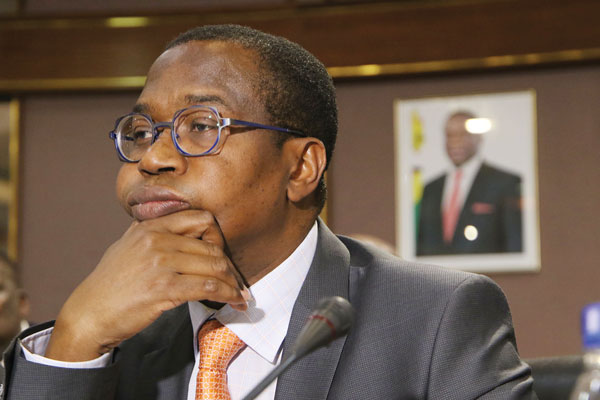
The sharp rise in inflation figures from 5,39% to 20,85% highlights worsening fiscal and monetary situation in the country, bringing in sharp focus the challenges Finance minister Mthuli Ncube is facing.
BY TATIRA ZWINOIRA
Ncube had for the past few months been touting a 6% inflation figure in the medium term on the back of Treasury’s fiscal and monetary interventions since he came into office.
However, on Tuesday, the Zimbabwe National Statistics Agency revised upwards its year-on-year inflation to 20,85% for October 2018, up a whopping 15,46 percentage points from the previous month’s 5,39% comparative indicating a lot more still needs to be done.
The latest inflation figures come barely a week after central bank governor John Mangudya stated that “while inflation may go over the 7% mark, it is expected to revert to below 7% in the short to medium-term” at a pre-budget seminar in Bulawayo.
While the inflation rate is based on the consumer price index that saw price increases spike in October, the double-digit figure is well over the Sadc average of between 3% and 7%.
Analysts says Ncube should urgently look at the high domestic debt, fiscal deficit, rising government expenditure, currency disparities high money supply that are driving inflationary pressure.
Money supply
- Chamisa under fire over US$120K donation
- Mavhunga puts DeMbare into Chibuku quarterfinals
- Pension funds bet on Cabora Bassa oilfields
- Councils defy govt fire tender directive
Keep Reading
Inflationary pressures in the economy are being caused by the growing money supply from the increase in Treasury Bills (TBs) and government’s overdraft with the central bank.
At the end of August 2018, broad money supply shot up to $9,79 billion at a time when TBs in issuance stood at $7,6 billion from $2,1 billion at the end of 2016.
Also, at the end of the period, government had borrowed $2,3 billion from the Reserve Bank.
Why these increases in money supply have increased inflationary pressures is due to the fact that the rise in money supply without a corresponding increase in production creates inflation.
“Money supply growth between last year July and August this year rose about 50%, whereas the productive capacity of the economy did not actually increase by that much. So that obviously increases aggregate demand in the economy and we ended up with a situation whereby too much money is chasing too few goods,” economist Prosper Chitambara said.
He added that when money supply is increased without a corresponding increase in the productive base of the economy, inflation is created by the shortfall between demand and supply.
According to provisions in Section 11(1) of the Reserve Bank Act [Chapter 22:15], lending by the Reserve Bank to the State at any time shall not exceed 20% of the previous year’s government revenues.
To curb the increase in money supply, at the start of the month, the central bank started inviting tenders on behalf of government for investors to participate in the auction system of TBs to curb its issuance.
For the overdraft facility at the central bank, Ncube said controlling it would be based on “fiscal discipline”.
High domestic debt
Due to the increased usage of TBs and central bank overdraft, the Parliament Budget Office (PBO) expects domestic debt to grow by $2,5 billion to $8,5 billion by year end.
The PBO found that from $4 billion in 2016 to $6 billion by end of 2017, domestic debt would grow as government has increasingly turned to TBs and the central bank overdraft to fund its critical expenditure.
Already, as at the end of September 2018, domestic debt was $9,5 billion as an effect of TBs and the overdraft facility.
This has pushed the total debt to gross domestic product (estimated at 88% in 2017) above the legal threshold prescribed in Section 11(2) of the Public Debt Management Act [Chapter 22:21], according to the PBO.
Fiscal deficit
The high domestic debt has translated to a budget deficit (fiscal deficit) of $2,5 billion as at the end of September 2018, due to the revenue and expenditure performance, against a target of $715,4 million.
“I think one of the primary reasons behind it (inflation) is the increase in money supply because of the fiscal deficit and we have been saying this for a long time,” economist Ashok Chakravarti said.
“If you look at the presentation of the Ministry of Finance at the parliamentary pre-budget workshop (last week), he (Ncube) said the September (2018) fiscal deficit for the first time in many years had been brought down to almost zero. This means he (Ncube) is turning off the tap in terms of increase in money supply which is going into RTGS [real time gross settlement] balances.”
He said if Ncube could keep this up in the coming months, inflationary pressures would reduce.
Driving this revenue and expenditure performance is government’s growing wage bill which is its major cost, at a rate faster than its income.
Currently, wages are chewing over 80% of government revenues leaving it with no choice, but to borrow money to finance its budget.
Currently, government’s wage bill is seen growing by 16% this year to $3,7 billion, rising to $3,9 billion next year pushing the budget deficit to nearly 14% of the gross domestic product (GDP).
What caused this increase in wages was a 17,5% bump in salaries for government workers from July 2018.
With Ncube last week promising a bonus incentive for civil servants before end, the wage bill could reach even higher levels than the current $3,7 billion expected.
The effect of this could put more strain on government to borrow more money to meet these costs, thus increasing the money supply and eventually inflation.
Currency
In its latest South African monitor report for December 2018 released yesterday, United Kingdom based financial services company Fitch Solutions said Zimbabwe’s cumbersome and inefficient monetary system would constrain the economy through higher-than-reported levels of price growth.
“Since this multi-currency system was adopted in 2009, the US dollar has been the primary transaction currency, but the South African rand, Botswana pula, British pound and Chinese yuan are also permitted for transactions in the country. However, current account deficits and insufficient foreign investment over recent years have eroded the country’s stock of foreign exchange,” Fitch Solutions said.
If government does not improve its production to generate foreign currency, aggregate demand will continue to outweigh supply, as alluded to by Chitambara, which will continue inflationary pressures.
Without forex, the supply of real money will not be able to meet demand.







